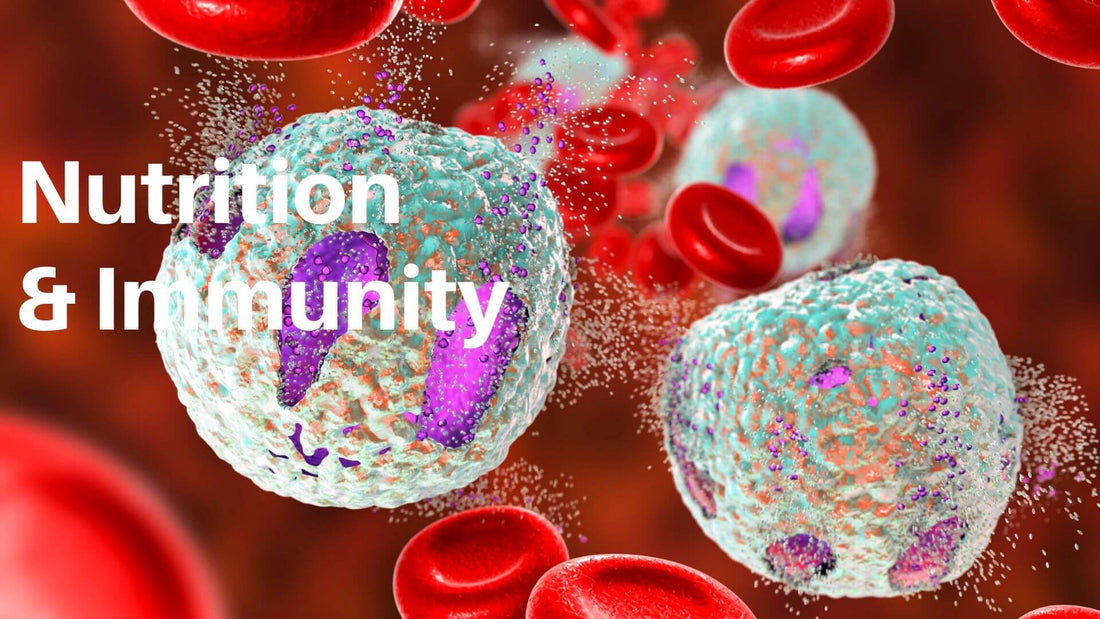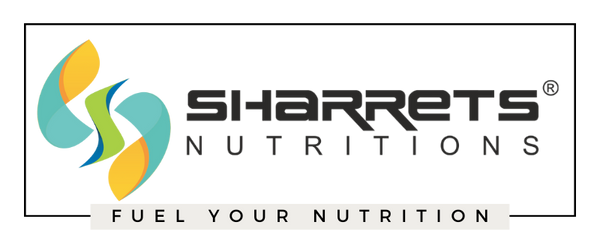
Know more about Nutrition and the immune system
Share
Nutrition and Immunity
CONTENTS : FOREWORD I WHAT IS IMMUNITY ? I THE INNATE IMMUNE SYSTEM I THE ADAPTIVE IMMUNE SYSTEM I IMMUNE REGULATION AND DYSFUNCTION I THE IMMUNE SYSTEM THROUGH THE LIFETIME I NUTRITION AND THE IMMUNE SYSTEM I VITAMINS AND MICRONUTRIENTS I THE TRADITIONAL CONCEPT OF IMMUNO MODULATION GUT HEALTH, PROBIOTICS AND IMMUNE MODULATION I THE WAY FORWARD I REFERENCES I GLOSSARY

FOREWORD
We live in an era of global warming, increasing pollution, lifestyle diseases, epidemic, and pandemic infections throughout the globe. All these factors challenge our defense system, and there is an urgent need to keep this system functioning optimally.
So, what is this natural defense system or the immune system? Have you ever wondered how our body’s natural defense protects us from the trillions of microbes surrounding us? How does it differentiate the self from non- self? How does this system regulate itself? Why are we not reacting to everything we eat? Have you ever wondered how a mother’s body knows a fetus is not a foreign object to be rejected but rather nurtured ?
Our immune system is a tightly regulated intricate network of cells and soluble factors, which interact with each other,attack the invading pathogen, and helps to eliminate it. The system evolves naturally from infancy to adulthood and declines with age. Several factors like age, nutrition, hormones, and stress, influence the immune system.
Ayurveda and traditional medicine systems have advocated holistic management of health and immunity.
The concept of immunity is based on homeostasis between the body, mind, nutrition, digestion, and the cells and tissues. There is increasing evidence demonstrating that nutrition has a direct impact on the maintenance of this homeostasis and the immune system.
In this white paper, we explore the concepts of immunity, the development of the immune system as well as explore the role of some nutrients based on Ayurveda and other traditional knowledge, and modern science to help communities all over the world.

What is Immunity ?
Immunity is defined as the ability of an organism to resist infection, disease, or any foreign invasion while balancing the autoreactivity and maintaining self-tolerance. Immunity is mediated by sensitized white blood cells and proteins called antibodies[1]. Humans share the environment with pathogenic, commensal, and non-pathogenic microbes in a crowded and polluted space.
The pathogens spread by diverse mechanisms and try to deceive the immune system, which in turn tries to eliminate these organisms while preserving the commensal microbes and avoiding excessive damage of self-tissues.
The most intriguing feature of the immune system is the mechanisms of detecting structural features of the pathogen or toxin that mark it as distinct from host cells and selectively eliminate them. The immune system distinguishes the infected, dying, or tumor cells by recognizing a variety of “danger” cues called danger-associated molecular patterns (DAMPs) and the infectious microbes by pathogen- associated molecular patterns (PAMPs).
The process of recognition of pathogens or toxins is divided into two systems.
The nonspecific innate immunity is like the border security force. The cells of the innate immune system are present in the skin mucosal surfaces and other exposed areas. The components of innate immunity include cellular and molecular features to recognize molecules that are peculiar to pathogens but not found in the host. Phagocytic cells like neutrophils, macrophages, and the antimicrobial compounds secreted by them constitute the innate immune system. In contrast, adaptive immunity is very specific and responds to the particular pathogen with high affinity and has the incredible property of memory [2].
THE INNATE IMMUNE SYSTEM
The innate defense mechanisms are encoded in the germline and can be categorized into the physical, physiological, phagocytic and the inflammatory mechanisms [3].
Skin and the mucus layer in the respiratory, gastrointestinal, and genitourinary tracts are the physical barriers that prevent the entry of organisms.
Unfavorable body temperature, acidic pH of tears, and gastric secretion are primary barriers to prevent the growth of microbes. The microbes get inactivated by the soluble proteins present in the biological fluids to control the spread of infection[4-6].
The phagocytic barrier includes blood monocytes and neutrophils, which engulf the pathogen and kill them. Finally, the inflammatory barrier gets activated by the tissue damage caused by the invading pathogen. This releases various vasoactive and chemotactic factors. These factors induce increased blood flow to the area, increased capillary permeability, and an influx of white blood cells. The serum proteins contained in the exudate have antibacterial properties, and a complex sequence of events initiates the inflammatory response to remove the pathogen.
The innate immune cells specialized for specific functions include the monocytes, macrophages, dendritic cells, basophils, eosinophils, neutrophils, mast cells, and natural killer cells. They express toll-like receptors (TLRs), which recognize general danger or pathogen-associated patterns[7]. This system is not only essential for detecting and eliminating harmful pathogens but is also crucial to maintain normal tissue homeostasis, by repairing damaged tissues and eliminating senescent or apoptotic cells.
An essential function of innate immunity is the rapid recruitment of immune cells to sites of infection and inflammation through the production of inflammatory cytokines, chemokines, biogenic amines, and eicosanoids[8]. These cytokines include tumor necrosis factor alpha (TNF-), interleukin 1 (IL-1) and interleukin 6 (IL-6) that attract additional innate immune cells such as neutrophils, natural killer (NK) cells, and monocytes to the site of infection[9], and stimulate acute phase proteins which are essential for the clearance of many pathogens.
They also contribute to the development of fever[10]. In response to viral infection, type I interferons secreted can antagonize virus replication and activate NK cells cytotoxicity against virus-infected cells [11].
THE ADAPTIVE IMMUNE SYSTEM
Adaptive immunity is competent of recognizing and selectively eliminating specific foreign molecules & microorganisms .The characteristic attributes of adaptive immunity are antigen specificity, diversity, memory and self/non self recognition.
adaptive responses are based primarily on the antigen-specific receptors expressed on the surfaces of T- and B-lymphocytes[12]. The assembly of antigen receptors from a collection of a few hundred germ-line-encoded gene elements permits the formation of millions of different antigen receptors, each with potentially unique specificity for a different antigen.
Upon encountering antigens, lymphocytes proliferate and differentiate into specialized subsets.
The B lymphocytes differentiate into plasma cells and secrete antibodies, whereas T lymphocytes differentiate into helper and cytotoxic subsets.
A distinct set of cytokines are produced by these cells to help them in their effector activities.
The T helper cells (CD4+) cells primarily differentiate into Th1, Th2, and Th17 subsets and play an essential role in mediating the immune response by directing other cells to perform the tasks. The Th1 response is characterized by the production of interferon gamma (IFN-), which activates the bactericidal activities of macrophages. It enhances immunity to viruses, intracellular pathogens, and help B cells in making opsonizing antibodies that improve the efficiency of phagocytes.
The Th2 response is distinguish by the release of cytokines (IL-4, 5 and 13) which are involved in the development of immunoglobulin E (IgE) antibody-producing B cells, as well as the development and recruitment of mast cells and eosinophils that are essential for effective responses against many parasites and allergy.
Th17 cells characterized by the production of cytokines of the IL-17 family are associated with inflammatory responses, particularly in chronic infection and disease[13, 14]. The cytotoxic T lymphocytes directly kill the cells harboring the intruder. Importantly, specialized B and T lymphocytes, known as regulatory cells, check the indiscriminate or indefinite progression of the immune response [15]. Few of these lymphocytes differentiate into memory cells and ensure that a second encounter with the same invader is dealt with swiftly and effectively [16].
Adaptive immunity is not independent of innate immunity. The phagocytic cells pivotal to nonspecific immune responses are intimately involved in activating the specific immune response by presenting the antigen to the T lymphocytes. These cells are known as antigen-presenting cells [APC], and the most competent among them are dendritic cells (DCs). The APCs package antigenic peptides into major histocompatibility complex (MHC) proteins (human leukocyte antigens in humans), ensuring that the nonself peptide is presented to the T lymphocyte with optimal specificity and affinity[17,18].
While the innate and adaptive immune responses are fundamentally different in their mechanisms of action, the synergy between them is essential for effective immune response.
IMMUNE REGULATION AND DYSFUNCTION
An immune response is associated with inflammation, and a quick resolution of this inflammation is essential to prevent chronic inflammatory diseases. The immune system is tightly regulated to resolve the inflammation to prevent unwanted tissue damage. Coordinated resolution mechanisms create a favorable environment for the return of immune homeostasis. These mechanisms halt the recruitment of leukocytes, induce apoptosis, promote the clearance of dead cells, and reprogram the macrophages to a pro- resolving subtype [19].
Sometimes the immunity fails to protect the host adequately or misdirects its activities to cause discomfort,disease , debilitating , or even death. The most common diseases are allergy, asthma, autoimmune diseases, and immune deficiency caused by an overactive response, inability to recognize self, and ineffective response.
IMMUNE SYSTEM THROUGH THE LIFETIME
The immune system keeps evolving throughout our lifetime. At birth, the infants’ immunity depends upon the antibodies and gut flora passed from their mother.
Over time the immune system strengthens as the baby gets exposed to external food and the environment.
Vaccinations and good nutrition help in building a robust immune system. The commensal bacteria in the gut are essential for digestion and acquisition of vital nutrients and also impact the development of the immune system[20]. As the child grows, the immune repertoire is also shaped by infections and vaccinations. In adulthood, the memory cell repertoire expands and peaks. The expansion occurs due to continuous exposure to pathogens, the microbiome, food, and the environment. As age advances, the immune system undergoes profound remodeling and decline. This immune senescence predisposes older adults to a higher risk of infections [21].

NUTRITION AND THE IMMUNE SYSTEM
Adequate and appropriate nutrition is required for all cells to function normally. An activated immune system demands higher energy and proper nutrition for optimum activity.
Some micronutrients and dietary components have very specific roles in the maintenance & development of an effective immunity throughout the life course or in reducing chronic inflammation.
The immune cells are also highly sensitive to nutritional deficiencies as they require high energy for their activity. An optimal intake of nutrients maintains immunological balance and strengthens the immune defense mechanism.
VITAMINS & MICRO NUTRIENTS
Vitamin A
Vitamin A (retinoid) is a fat-soluble vitamin, which is essential for maintaining vision and promoting growth and development. It helps to maintain the structural and functional integrity of mucosal cells in innate barriers and plays a significant role in maintaining the normal functioning of innate immune cells (NK cells, macrophages, neutrophils)[22]. Dietary intake of Vitamin A is required to promote the proliferation and to regulate the apoptosis of thymocytes. The vitamin helps in the proper functioning of T and B lymphocytes, and efficient antibody response to antigen.
It is also involved in the development and differentiation of T cells and their effector functions[23]. Retinoic acid promotes cellular differentiation and influences the secretion of key cytokines produced by macrophages. Vitamin A, thus influences the innate and adaptive immune system and balances the immune response to provide enhanced defense against multiple infectious diseases [24].
Vitamin B complex
The water-soluble vitamin B complex plays an essential role in balancing the immune system. Vitamin B1 deficiency is associated with neuroinflammation and overexpression of proinflammatory cytokines.
Vitamin B2 or riboflavin is important in developing the mucosal immunity, and Niacin (Vitamin B3) potentiates innate immunity while dampening excess inflammation. Vitamin B6 helps to regulate the inflammation by regulating cytokine production and NK cell activity. It also regulates the proliferation, differentiation, and maturation of lymphocytes and maintains the Th1 immune response[25]. In a clinical study, supplementation of Vitamin B6 increased the T-helper cell numbers and the percentage of T-suppressor cells, thus helping in balancing the immune response in critically ill patients[26]. Vitamin B12 plays a significant role in immune system regulation.
It helps to regulate the NK cell functions and modulates the immune system related NK cells, and CD8+ T cells[27]. Vitamin B12 is also reported to be involved in facilitating the production of T lymphocytes that are involved in humoral and cellular immunity [28].
Vitamin C
Vitamin C is a water-soluble essential antioxidant and a cofactor for many enzymatic reactions in the body, including synthesis of hormones, collagen, and immune potentiation[32]. It contributes to immune defense by supporting various cellular functions of both the innate and adaptive immune system.
Deficiency of Vitamin C results in impaired immunity and higher susceptibility to infections. Vitamin C is reported to show an effective antioxidant property that protects against ROS and RNS produced when pathogens are killed by immune cells[33].
They regenerate essential antioxidants such as glutathione and vitamin E to their active state[33], promotes collagen synthesis, thereby supporting the integrity of epithelial barriers[34]. Vitamin C also stimulates the production, function, and movement of leukocytes (e.g., neutrophils, lymphocytes, phagocytes) [33].
It increases serum levels of complement proteins[35], has roles in antimicrobial and NK cell activities and chemotaxis[34]. It is involved in apoptosis and clearance of spent neutrophils from sites of infection by macrophages[36]. Supplementing with vitamin C appears to be able to both prevent and treat systemic and respiratory infections.
It also plays a critical role in antiviral immune responses against influenza virus-mediated by increasing IFN/IL-1α/β production.
Vitamin D
Vitamin D is a fat-soluble vitamin that plays a crucial role in modulating the immune response. The receptor for the vitamin is expressed in innate immune cells such as monocytes, macrophages, dendritic cells. It enhances the innate immunity by inducing the production of endogenous antimicrobial peptides in monocytes/ neutrophils and increases the phagocytic activity of monocytes[37, 38]. Vitamin D favors the regulatory Th2 and Treg cell development by reducing the T lymphocyte polarization towards proinflammatory Th1 and Th17 cells[39]. It is also reported to inhibit the production of cytokines, IL-2, and INF-γ.
This helps in modulating the immune system against external stimuli[40]. Vitamin D reduces NF-B mediated inflammation in innate immune cells. Simultaneously, it increases the expression of CD14 and cathelicidin in macrophages, which help in eliminating pathogens and viruses[41].
Vitamin E
Vitamin E, a fat soluble vitamin, is an antioxidant and plays a vital role in modulating the host’s immune response. Its deficiency is known to impair both humoral and cell-mediated immunity[29]. It can enhance T cell-mediated function by directly promoting membrane integrity and positively modulating the signaling events in T cells while also protecting T cell function indirectly by reducing production of T cell- suppressing factors. Vitamin E has been shown to inhibit PGE2 production, thereby preventing the suppression of T cell activation[30]. Mice fed with Vitamin E show a better resistance against influenza viral infection associated with improved Th1 response [31].
Zinc
Zinc is ubiquitous in all living cells. It acts as a cofactor for more than 300 enzymes involved in cell proliferation, DNA replication, and signal transduction. Zinc is a micronutrient crucial for maintaining homeostasis of the immune system. The deficiency of zinc negatively impacts immune cell development and functions in both innate and adaptive immunity. Zinc modulates the immune system by regulating T cell count, NK cell activity, macrophage function, neutrophil function and T-cell dependent antibody production[42]. Zinc is a general stimulant of antiviral immunity and maintains immune tolerance by reducing the differentiation of proinflammatory Th17 and Th9 cell differentiation[43]. The antioxidant effect of Zinc protects against unwanted ROS and RNS, maintains the skin and mucosal membrane integrity and induces the proliferation of cytotoxic T cells, thus helping both innate and adaptive immune response[33].
Selenium
The trace element selenium (Se) is of fundamental importance to human health.It is an essential component of several vital metabolic pathways, including the antioxidant defense system, and the immune system functioning. The immune- modulating effect of selenium helps in regulating various functions including T cell proliferative responses, lymphokine-activated killer cell activity, natural killer cell activity, delayed-type hypersensitivity responses and responsiveness to vaccines[44]. Selenium induces a phenotypic switch in macrophage activation from a classically activated, pro- inflammatory phenotype (M1) towards an alternatively activated, anti-inflammatory phenotype (M2). Several studies have demonstrated that selenoproteins regulate migration and phagocytosis functions in macrophages[45]. Supplementation with Se in adult human subjects with relatively low levels of the mineral in serum, was found to enhance lymphocyte antioxidant activities, and augment host immune responses to infection[46].
Supplementation was also reported to improve cytotoxic lymphocyte- mediated tumor cytotoxicity and NK cell activity and increase percentages of activated T cells and antibody responses to vaccines[47].
Age related decline in immune response in the elderly was reported to be restored with dietary selenium supplementation[46]. Activated immune cells require higher levels of selenoproteins.
Selenium supplementation upvregulates the synthesis of selenocysteine and upregulation of interleukin- 2 receptor expression in activated lymphocytes and NK cells [48].
Omega fatty acids
The impact of dietary polyunsaturated fatty acids (PUFAs), focussing on omega-3 PUFAs on the immune system, has been explored for decades. Both omega-3 and omega-6 derived metabolites have immune-regulatory functions. These metabolites are generally known as pro-resolving mediators[49]. Omega-3 fatty acids alter the production and secretion of cytokines and chemokines, phagocytic activity, and macrophage polarization.
The omega-3 fatty acids eicosapentaenoic acid (EPA), and docosahexaenoic acid (DHA) are able to suppress inflammasome-mediated inflammation in macrophage cell lines as well as in primary human and mouse macrophages[50, 51]. They promote M2 polarization in macrophage cell lines and primary mouse macrophages, which results in the resolution of inflammation[52]. The metabolite of omega-3 fatty acid (resolvin D1) reduces neutrophil migration. They influence adaptive immunity by modulating T cell polarization.
Omega-3 fatty acid supplementation reduces IL-17 plasma levels in children with asthma and promotes differentiation into regulatory cells[51, 53]. EPA and DHA increase IgM production by B cells by increasing the number of antibody- producing cells in mice and human[54]. They decrease the IgE-mediated activation of mast cells in several animal models and human cells. The dampening effect of omega-3 fatty acids on mast cell activation has been employed to decrease the severity of allergy or atopic dermatitis[55]. Resolution of inflammation is a crucial factor for immune homeostasis, and in this context, dietary PUFA helps prevent a chronic inflammatory condition.
TRADITIONAL CONCEPT OF IMMUNOMODULATION
The basic concept of immunomodulation in traditional medicines is to enhance the body’s overall natural resistance to the disease-causing agent rather than directly neutralizing the agent itself. The concept of immunity is understood as the capacity to inhibit the causes and factors of the disease.
The role of emotional and psychological factors, environment, age, seasonal variations, and nutrition are thought to play a role in the proper functioning of the immune system.
The traditional Ayurvedic system also believes in using Rasayana, which is supposed to strengthen vitality and strength with a natural resistance against aging and disease [56].
Ashwagandha
Ashwagandha has been used for centuries in India as an adaptogenic agent to build resistance to stress and diseases. Some of ashwagandha’s major bioactive molecules involved in modulating the immune system include withanolides, withanosides, and withaferin-A. Withanolide A was found to augment the mitogen-induced T lymphocyte proliferation, suggesting an immunostimulatory activity. Withaferin-A and Withanolide A abrogate the corticosteroid- induced suppression of Th1 response, which was attributed to its anti-stress activity[57]. Ashwagandha extract has been shown to increase IgM production, improve macrophage activity, and potentiate the NK cells[58]. In an in vivo study, ashwagandha prevented the myelosuppression in mice treated with immunosuppressive drugs as well as showed immune stimulatory activity [59].
Guduchi ( Tinospora Cordifolia)
Guduchi has been used for centuries in the Ayurvedic and Unani medicines. Guduchi contains alkaloids, steroids, glycosides,and polysaccharides. It has been shown to enhance the phagocytic and bactericidal activities of macrophages and neutrophils. The extract protected mice against lipopolysaccharide (LPS) induced endotoxic shock by modulating macrophages ’responses.
It has also been shown to control the drug-resistance of Mycobacterium tuberculosis infection by inducing Th1 immune responses[60, 61]. The water extract of guduchi promotes neutrophil activity and reduce allergic rhinitis. The polysaccharide component G1-4A acts as TLR4 agonist and is known to have immunostimulatory properties [62].
Shatavari ( Asparagus racemosus)
Shatavari is used to prevent aging, increase longevity,impart immunity, improve mental function, vigor, and add vitality to the body. It is also used in nervous disorders, dyspepsia, tumors, inflammation, neuropathy, and hepatopathy[63].
The satavarins from shatavari are reported to stimulate immune cell proliferation and IgG secretion in a dose dependent manner. It also stimulates Interleukin (IL)-12 and inhibits IL-6 production[64].
Black Pepper ( Piperine)
Black pepper is the most commonly used spice, but also one of the most valuable medicinal plants. It is considered asthe “king of spices”, among others. Piperine, a pungent alkaloid, is the major metabolite of the plant. It contains fibers, starch, proteins, carbohydrates, lignans, alkaloids, flavonoids, phenols, amides, and essential oil.
The major compounds found in the essential oil are sabinene, -pinene and -pinene, -caryophyllene, phellandrene, limonene,linalool, citral and others[65]. Piperine is reported to increase the bioavailability of many drugs and nutrients. It helps modulate the immune system by increasing the body’s defense mechanism by augmenting the production of WBC, cytokines, and macrophages.
Piperine administration in Balb/c mice showed an increase in the total WBC counts[66]. Piperine treated mouse splenocytes demonstrated an increase in the secretion of Th-1 cytokines (IFN- and IL-2), increased macrophage activation, and proliferation of T and B cells[67].
Long Pepper (Piper longum)
Long pepper has a long history of culinary use. As a medicinal herb, it has been used in various formulations as an appetite stimulant, antitussive and immunostimulant[68].
The fruits contain 1% volatile oil, resin, alkaloids (piperine and piperlongumine) and a terpenoid substance. The roots contain the alkaloids piperine, piperlongumine or piplartine[68]. Long pepper extract effectively reduced passive cutaneous anaphylaxis in rats and protected guinea pigs against antigen- induced bronchospasm. In an in vitro study, a 30% protection of mast cells was observed[69].
The individual alkaloids were also shown to block histamine release in animal models. Long pepper is clinically proven to be useful in the management of bronchial asthma in children. In a classic study, 240 children with asthma, 58.3% showed decreased severity of attacks[70]. In another investigation, 20 children were monitored for one year with the same treatment. Of these, 11 had no recurrence of attacks.
All patients had a strongly positive skin test which became negative in six and decreased significantly in 12 after five weeks of treatment[71]. A total of 159 phytochemicals were identified from long pepper. Among those, 106 phytochemicals reported to regulate 19 immune pathways of human[72]. Piperine, the main component of long pepper shows profound inhibitory effects on airway inflammation in a murine model of asthma.
This effect was mediated by the suppression of Th2 cytokines (IL-4, IL-5, IL-13). Apart from cytokines, immunoglobulin E, eosinophil CCR3 expression was also reduced. Increased TGF- gene expression in lung suggests that piperine may act as a potential immunomodulator by downregulating Th2 cytokines[73].
Vasaka ( Adhatoda vasika)
Vasaka has been traditionally included in ayurvedic preparations for the relief of cough, bronchitis & asthma . The plant has been recommended by Ayurvedic physicians for the management of various types of respiratory disorders[74]. The leaves of the plant contain essential oil and the quinazoline alkaloids vasicine, vasicinone and deoxyvasicine.
The essential oil is known to have smooth muscle relaxing properties. Antitussive activity has been demonstrated in animal models. Vasicine has been reported to be responsible for most of the pharmacological activities of vasaka. Synthetic analogs of vasicine have been shown to decrease Th2 cytokine release and eosinophil recruitment to the airways of mice and exhibit antiasthmatic effect in an ovalbumin induced-mouse model of asthma[75]. Ambroxol, a widely used secretolytic agent is developed from vasicine. It inhibits the IgE-dependent activation of mast cells and basophils, and secretion of IL-4 and IL-13, thus controlling allergic inflammation[76].
Indian ipeacac (TYLOPHORA INDICA (ASTHMATICA)
Indian ipecac has been used traditionally in the management of bronchial asthma and respiratory problems and may act by direct stimulation of the adrenal cortex. The extract from the leaves was reported to suppress cell-mediated immunity but not the antibody response[77]. Several studies confirmed the value of Indian ipecac in the treatment of bronchial asthma and allergic rhinitis[78]. A double-blind study in 103 patients with asthma,
alcoholic extracts of Indian ipecac showed an improvement in asthmatic symptoms, including lung oxygen capacity[79]. In another clinical study, a marked reduction in nasal obstruction with sneezing was observed with the leaf extract[80]. The alkaloid, tylophorine and its analogs were found to reduce the cytopathic effect induced by human severe acute respiratory syndrome coronavirus (SARS CoV) in Vero 76 cells in vitro[81].
Andrographis paniculata
Andrographis has been used in Nordic countries to provide relief from and to reduce the duration of symptoms of the common cold and flu. This plant is traditionally used in the management of infections through strengthened immune functions.
The pharmacological effects of the plant are attributed to the presence of the primary active principles, andrographolide and its derivative deoxyandrographolide, with beneficial effects on liver and serum enzymes, anti-inflammatory activity, antipyretic effects, and pituitary- adrenal cortical activity. The methanol extract of andrographis and andrographolide inhibited LPS-stimulated NO production and NF-B activation in macrophages [82].
Andrographolide exhibits immunomodulatory effects by effectively improving cytotoxic T cells, natural killer (NK) cell activity, phagocytosis, and antibody-dependent cell-mediated cytotoxicity (ADCC)[83]. The compound has also been reported to suppress IL-2 production and T-cell proliferation in a mixed lymphocyte reaction and to inhibit dendritic cell maturation and antigen presentation, which supports the therapeutic value of andrographolide in the treatment of asthma[84]. Andrographolide was shown to effectively inhibit different strains of influenza viruses both in vitro and in vivo[85], while clinical studies revealed the efficacy of andrographis extract in reducing cold and flu symptoms[86].
Foleus
Foleus is the only known plant source of the adenylate cyclase and cAMP activator, forskolin.In vitro studies demonstrated the property of forskolin to inhibit the release of mediators including antigen induced histamine release in the human hypersensitivity reaction[87].
An in vitro study employing human peripheral blood basophils demonstrated that forskolin significantly suppressed the release of the cytokines interleukin (IL-4 and IL-13) which are secreted by the basophils after cross-linking of cell surface immunoglobulins. This finding validates the capability of forskolin to regulate the secretion of cytokines[88]. Clinical studies have validated the beneficial role of forskolin in the management of asthma[89].
Holy basil (Ocimum sanctum)
Holy basil, also known as Tulsi, belongs to the class of adaptogens that help to enhance adaptability to changing weather conditions. The leaves have been used in traditional Eastern medicine systems for centuries in formulations for the management of respiratory problems and to support healthy metabolic functions[90]. An immunomodulatory response balances and improves the body’s response in fighting against pathogens such as bacteria, microbes, viruses, allergens etc. Apart from the antiviral activity, the leaves of the plant are known to enhance both cellular and humoral immunity[91]. The aqueous extract of the leaves was reported to increase the count of neutrophil and lymphocyte and their phagocytic ability[40]. Healthy volunteers experienced an increase in interferon-, interleukin-4, as well as NK cells upon consumption of 300 mg ethanolic extract of holy basil leaves for four weeks[92].
Licorice ( GLYCYRRHIZA GLABRA)
Licorice helps to soothe the respiratory system. Licorice contains biologically active constituents including glycyrrhizin,and glycyrrhetin, with anti-inflammatory activity. Glycyrrhizin is a triterpene glycoside and a major active constituent of licorice. It was demonstrated to prevent the replication of SARS-associated coronavirus[93]. The study pointed out that at high doses, Glycyrrhizin, was more potent than antiviral drugs and was highly effective in eliminating the virus in vitro.
Glycyrrhizin has been reported with many immunomodulatory effects such as decreasing the recurrent attack rate of allergic rhinitis and asthma, improving semen quality with treatment, and modulating allergic inflammation in a murine model for asthma. Flavanoids from the plant were found to inhibit exotoxin secretion from lung fibroblasts in vitro suggesting its potential use in allergic asthma[94].
Turmeric ( Curcuma longa)
Turmeric, also known as “Indian saffron”, is a bright yellow spice herb which has used in the Indian subcontinent and Southeast Asia for many centuries. Curcuminoids consisting of curcumin, demethoxycurcumin and isdemethoxycurcumin are the major active ingredients of the plant. Curcuminoids and their hydrogenated derivatives are powerful antioxidants and antiinflammatory compounds. Curcumin interacts with various immunomodulators, including dendritic cells, macrophages, B and T lymphocytes, cytokines, and various transcription factors. In an in vitro study, curcumin inhibited PHA-induced T-cell proliferation, interleukin-2 production,
NO generation, and lipopolysaccharide induced nuclear factor-kappaB (NF-B) and augmented NK cell cytotoxicity[95]. Several studies have shown that curcumin could inhibit viral uptake and replication in vitro[96]. Extending these studies, in vivo data showed that curcumin treatment reduces lung inflammation due to influenza infection in mice and increases the antiviral immune response[97]. Curcumin was shown to reduce allergic inflammation by reducing the Th17 activation and maintaining the immune balance. It can also act as a scavenger of nitric oxide and could prevent bronchial inflammation in asthmatic patients[98].
Ginger (ZINGIBER OFFICINALE)
Ginger is a commonly used condiment in various food and beverages. It contains several active ingredients such as gingerols, shogaols, zingerone, paradol, and sesquiterpene hydrocarbons[99]. Ginger oil helps in modulating the immune system by inhibiting T lymphocyte proliferation and interleukin secretion[100]. Ginger oil is also a powerful antioxidant, and shows anti-ulcer, antibacterial activities. In an in vivo study, administration of ginger essential oil recovered the humoral immune response in immunosuppressed mice[101].
Black seed ( NIGELLA SATIVA)
Black seed is traditionally used in many medicinal applications. Black seed is a characteristic herbal medicine for diverse diseases in Unani, Indian, Arabic and Prophetic traditions. Black seed seeds contain fixed oil, volatile oil, quinones, alkaloids, saponins and other trace compounds. The active constituents of the oil include thymoquinone, nigellone, and alpha-hederin.
All these actives are reported to show anti-histaminic, anti-eosinophilic, anti-leukotrienes, anti-immunoglobulin, and reduced proinflammatory cytokine activity, thus helping in modulating the immune system[102]. In an in vitro study, black seed extract suppressed IL-2, IL-6, and PGE2 in T-lymphocytes as well as IL-6 and PGE2 in monocytes[103]. Black seed oil significantly inhibited cyclooxygenase (COX) and 5-lipoxygenase (5-LOX) pathways of arachidonate metabolism in rat peritoneal leukocytes[104].
Drumstick (MORINGA OLEIFERA)
Drumstick tree is said to provide seven times more vitamin C than oranges, ten times more vitamin A than carrots,17 times more calcium than milk, 9 times more protein than yogurt, 15 times more potassium than bananas and 25 times more iron than spinach[105]. The presence of phytochemicals makes it a good medicinal agent. A methanolic extract of drumstick tree leaves showed an increment in WBC, lymphocyte, and neutrophil counts[106].
GUT HEALTH, PROBIOTICS AND IMMUNE MODULATION
Probiotics are the living microorganisms that confer health benefits to the host when consumed in an adequate amount.
The primary genera of probiotic microorganisms include Lactobacillus (L.), Bifidobacterium (B.), and Streptococcus (S.). Probiotics confer a array of health benefits related to regulation of inflammation, respiratory tract infections, neuropsychiatric disorders, satiety and improvement in anxiety and depression. The health benefits of probiotics are thought to be mediated because of the “gut–brain axis”, which is the extensive communication between the gastrointestinal and central nervous systems[107]. Dietary intake of probiotics improves the immune system by interacting with gut mucosa and mucosal immune system.
They interact with intestinal epithelial cells[108], M-cells in Peyer’s patches[109], and dendritic cells[110]. Apart from improving the immune system of the gut, probiotics are also reported to positively impact on the systemic immune system. By modulating the pro and anti- inflammatory cytokines, they facilitate immune response against infection and regulate excess inflammatory reaction, leading to balanced homeostasis[111, 112]. Intake of fermented milk containing Lactobacillus was reported to reduce the duration of respiratory and gastrointestinal infections[113, 114], as well as reduce the risk of the common cold[115].
Also, participants receiving Lactobacillus casei for 5 months are reported to lower antigen-induced production of IL-5, IL-6, and IFN-, as well as increase IgG and decrease IgE levels in the serum[116]. Management of allergy through probiotics has also been demonstrated in infants, using Lactobacilli to control atopic eczema and cow’s milk allergy[117]. A systematic review of 23 trials involving 6269 children, concluded that probiotic consumption is a feasible way to decrease the incidence of RTIs in children[118].
Bacillus coagulans MTCC 5856 (LactoSpore®) is a gram-positive, spore- forming, L (+) lactic acid producing bacteria. It is a microaerophilic and thermostable organism, with GRAS (generally regarded as safe) affirmation from US FDA. LactoSpore is highly stable and can be incorporated into various functional food, such as beverages, baked food, and vegetable oil without losing viability[119, 120]. Clinical studies have proven the efficacy of this probiotic in maintaining gut health.
Clinical symptoms of diarrhoea predominant irritable bowel syndrome (IBS) was reported to improve in patients supplemented with LactoSpore[121]. Further, a second double blind, placebo controlled human trial demonstrated efficacy and safety of LactoSpore in patients with major depressive disorder (MDD) symptoms who were also suffering from IBS[122].
Evidence for the influence on immune system was further uncovered, when coagulans MTCC 5856 spores were evaluated in-vitro for their immunomodulatory properties. The spores were found to exert marked immunomodulatory effects in the colonic cells in vitro, by reducing the pro- inflammatory IL-8 secretion and increasing the anti-inflammatory IL-10 secretion[123]. Inflammatory gastrointestinal disorders are marked by an increase in gram-negativebacteria, causing low-grade inflammation and a loss of microbial diversity. The anti-inflammatory effect of LactoSpore is responsible for its influence on maintaining the immune homeostasis.
Apart from live cells, heat-inactivated Lactobacilli are reported to stimulate the functions of macrophages. Heat-killed strains are known to supress food allergy by regulating IgE mediated reactions, and polarized Th1 mediated immune response[124]. ImmunoSporeTM is the heat-inactivated form of LactoSpore. Research indicates it exhibits profound immunomodulatory activity.
The Way Forward
Diet and nutrition directly impact the development and function of the immune system .
Nutrients directly modify the action of immune cells or may exert their effect by modifying the gut microbiome. The immune system undergoes many changes over the course of life with distinct features at every phase.
The need for an adequate supply of micro and micronutrients to support the immune system is recognized at every stage. Phytonutrients, minerals and probiotics offer comprehensive immune system support by keeping it functioning without over responsiveness (inflammation) or under responsiveness illness and maintaining the immune homeostasis.
REFERENCES
1.Chaplin, D.D., Overview of the immune response. J Allergy Clin Immunol, 2010. 125(2 Suppl 2): p. S3-23.
2.Owen, J.A., et al., Kuby immunology. 2013, New York: W.H.Freeman.
3.Janeway, C.A., Jr. and R. Medzhitov, Innate immune recognition. Annu Rev Immunol, 2002. 20: p. 197-216.
4.Hiemstra, P.S., The role of epithelial beta-defensins and cathelicidins in host defense of the lung. Exp Lung Res, 2007.33 (10):p.537-42
5.Holmsko reconstruction of a mammalian transcriptional network mediating pathogen responses.Science, 2009. 326(5950): p. 257-63.
9 Kang, S.J., et al., Regulation of hierarchical clustering and activation of innate immune cells by dendritic cells. Immunity, 2008. 29(5): p. 819-33.restricted epitopes by the standard proteasome and the immunoproteasome. Curr Opin Immunol, 2001. 13(2): p. 147-
















